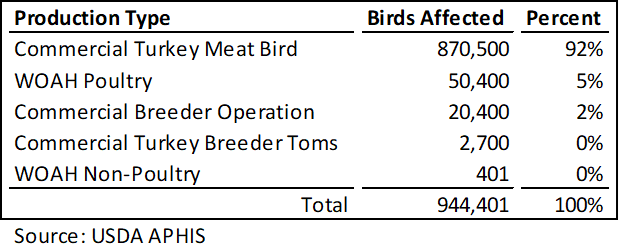HPAI Cases Returns to the US Hitting Turkeys the Hardest
Author
Published
11/2/2023
Highly Pathogenic Avian Influenza (HPAI) has returned to the United States. No commercial cases were detected in the US from May to September (Figure 1). So far in October, 34 cases have been identified, 21 in commercial flocks and 13 in backyard flocks.

Figure 1. US HPAI Cases
In October 2023, 944,401 birds were affected by HPAI according to data available on October 30, 2023. Of these, 92% were commercial meat turkeys. No commercial layer or commercial broiler cases were reported.
Table 1. US Birds Affected by HPAI in October 2023
Figure 1 shows the birds that have been affected by state in the past 30 days. Cases have been concentrated primarily in north, north central, and northwestern states. Iowa has had 3 new cases in October, 2 on commercial turkey farms and 1 in a backyard flock. A total of 98,350 birds have been affected from these 3 cases.

Figure 2. Birds Affected by State in the Last 30 Days; Source: USDA-APHIS
Given that most birds affected so far have been turkeys it is fair to wonder what this recent recurrence of HAPI will mean for Thanksgiving turkey prices. According to USDA-NASS, total turkey production in 2023 was expected to be 219 million head, so the recent October cases represent less than 0.5% of total turkey production for the year, although they do represent about 4.5% of October’s planned production. Previous losses from HPAI last spring should already be priced into the market. Furthermore, the US typically stores a large amount of frozen turkey in cold storage ahead of the holiday season. Given the small relative number of new birds affected and the fact that the US uses a lot of stored frozen turkey, this doesn’t look like it will be a big price mover yet. However, if HPAI continues to hit near market ready turkeys at a high rate, fresh turkey prices may move higher ahead of Thanksgiving.
Want more news on this topic? Farm Bureau members may subscribe for a free email news service, featuring the farm and rural topics that interest them most!